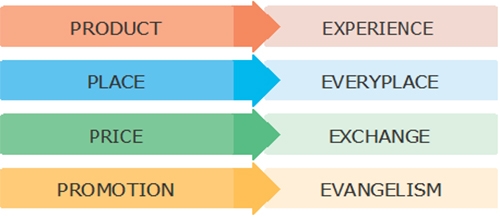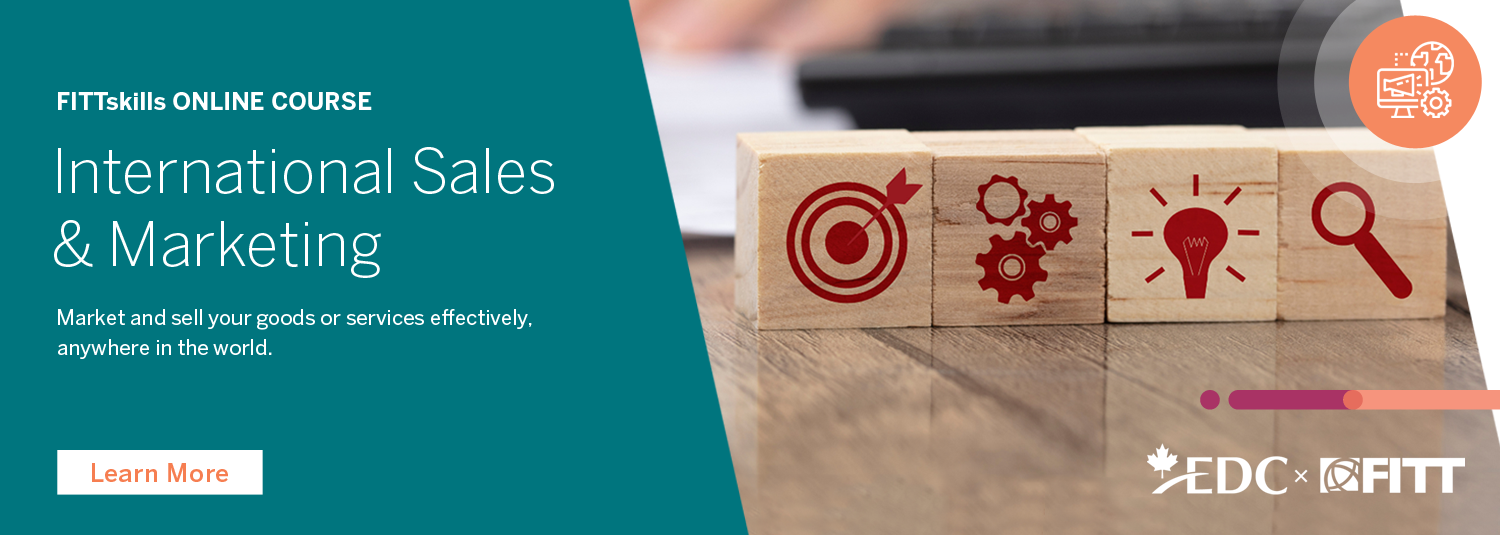
In the past, the marketing mix was commonly made up of the 4 Ps: product, price, place and promotion. An alternative to the 4 Ps approach is gaining popularity due to the digital age and the changing ways that customers gather information and make purchasing decisions. These are the 4 E’s.

According to Brian Fetherstonhaugh of Ogilvy & Mather, the market is now an ecosystem with “billions of unstructured one-to-one and peer-to-peer conversations”.
Fetherstonhaugh advises marketers to stop thinking so much about their product and start thinking more about the customer experience. This new approach encourages organizations to engage and create a relationship with visitors, leads and customers.
Now that marketers have better tools at their disposal, they can take a more targeted approach to sharing and gathering information. Digital channels, such as email, social media and mobile messages, allow businesses to share tailored content with segmented, regional audiences.
1. Experience
Instead of a marketing strategy that is planned around the product or service, this method puts the customer experience at the centre of attention. An example of an organization that changed its focus from products to experience is Hershey. Rather than putting up a billboard ad in New York City’s Times Square, they created a brand experience by opening a store on Times Square that is playful, stimulates childhood memories, and allows parents and children to explore candies together.
A customer’s journey is their overall experience with an organization from the time they first encounter its name. For example, customers might typically encounter an organization’s product on social media for the first time and from there go to the organization’s website to find more information, followed by a trip to a retail outlet to purchase the product. At some point, customers might return to the organization’s website to learn about a different product.
The organization’s goal is to make the journey enjoyable and relevant for the customer.
For example, consider the Swedish Tourism Association’s “Call a Swede” campaign. When tourists call +46 771 793 336, they are forwarded to a Swedish resident (a Swede) who provides the caller with the desired local knowledge, such as recommending a good restaurant, a fruitful fishing hole or a place to take Swedish folk dancing lessons.
Mapping the customer’s journey or path enables marketers to pinpoint weaknesses in the customer experience and correct them. The mapping exercise also identifies the technologies used, the people and processes involved, and the emotions experienced by customers along the path. It can be difficult to map the path because the customer’s journey is often non-linear and more complex than it was in the pre-digital era. It would be valuable at this point to consider when and how to collect customer testimonials at different points in their journey.
To assist with the mapping activity, marketers use customer personas for businesses and/or consumers.
Some organizations have deepened their relationship with loyal customers by using them as product and service experts. Customers who have developed product and service expertise are asked to help other customers in return for rewards. Consider the case of giffgaff, a British mobile phone operator that relies on knowledgeable customers to help other customers and promote its brand. The company rewards these customers with points, which they can convert into cash.
2. Everyplace
Everyplace is so named because of how consumers can now access information about products and services from multiple sources in multiple locations. Instead of expecting customers to come to the seller, the seller now goes to customers. This new dynamic allows the organization to provide information about its mission and products and services whenever and wherever customers seek it. And they seek it in many places, including social media, retail outlets, online stores, websites, blogs and more. The goal is to make contact with customers when they are receptive to it. For example, Ogilvy & Mather’s Digital Innovation Lab in Singapore invented an app for its liquor brand with a virtual personal assistant who helps customers by advising them of upcoming entertainment promotions and then, if desired, gets them reservations and VIP access to these events.
3. Exchange
In the 4 Es approach, the focus has moved from the exchange of money for a product or service to the value of the relationship and long-term loyalty customers develop with the organization. Using the exchange approach requires each party to offer something of value to the other party. For example, many organization websites offer expertise and products for free. Marketers use the exchanges to establish credibility, create goodwill and build a relationship of trust. What organizations offer customers in the exchange hopefully results in long-term relationships and ultimately brand loyalty and revenue.
4. Evangelism
Evangelism involves creating a brand experience for customers that inspires them to engage with the organization and tell their friends about the experience. Ogilvy & Mather recommends starting with an organization’s key strengths and connecting them to an important cultural truth or trend to generate energy and passion.
Take for example, Dove’s Campaign for Real Beauty. Dove’s stand on the beauty of real woman of various shapes, sizes and colours resonated with women. The inspiration for the program was a study of more than 3,000 women from 10 different countries. Results showed that only 2% of the respondents considered themselves beautiful.
The Dove Campaign for Real Beauty was based on the idea that the world would be a better place if women felt good about themselves. Missions such as these can inspire employees as well as customers.
The Campaign for Real Beauty started with a website and a public relations campaign. Women were invited to join the debate, and millions did. The campaign’s Evolution has been seen by an estimated 500 million viewers. All this was achieved through consumer sharing and free media support.
Dove’s most recent research showed that the percentage of women who consider themselves beautiful has increased from 2 to 4%, although the brand recognizes that this increase cannot be attributed to Dove alone. The campaign’s impact on perceptions of beauty is hard to quantify, but it has helped drive Dove sales to record levels. Dove’s sales increased from USD 2.5 billion in 2004, the first year of the Campaign for Real Beauty, to USD 4 billion in 2014.
Another example of marketers who are good at finding the energy and passion in what they sell is Coca-Cola. The company ran a global campaign in 2009 called Open Happiness. As a localized campaign activity, the marketing team in Singapore installed a Coke machine on a university campus with “Hug Me” written on it. Whenever someone hugged the machine, they were rewarded with a free Coke. The marketing teams in Pakistan and India came up with a different interpretation of the campaign. In their regions, whenever someone in India put their hand on a Coke machine at the same time as someone in Pakistan, both machines dispensed a free Coke.
Evangelism also involves creating products and services that are so good and providing experiences that are so intriguing that customers want to let other people know about them. Apple is an example of a company that has achieved an image with which people want to be associated.
Has your business followed the 4 E’s model? How do you think it stacks up to the traditional 4 P’s of marketing?







disqus comments